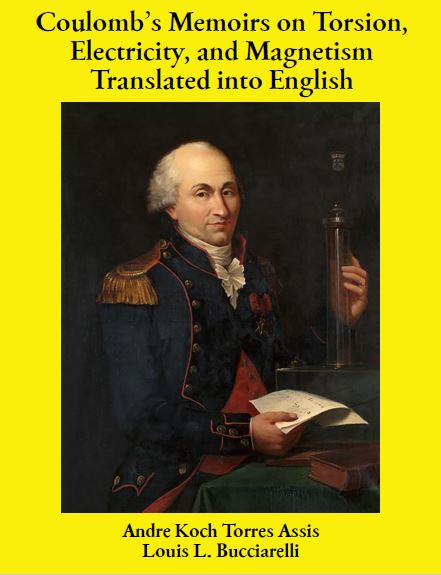
http://www.ifi.unicamp.br/~assis/Coulomb-in-English.pdf
Two forces and an included angle result in a torque perpendicular to the plane of these forces. The torsion balance fixes two forces, so the vibration of the balance beam can be used to measure the deflecting acceleration.
Review by Mathias Huefner
Over the last 35 years, André Koch Torres Assi’s main research topics have been the evaluation of historical texts on the force laws of Newton and Coulomb, Ampère’s force between current elements and Weber’s law as applied to electromagnetism and gravitation. He has also published several books on these subjects.
Now the complete English translation of Coulomb’s major works on torsion, electricity and magnetism is in seven memoirs before.
Most, if not all, of these memoirs were reprinted by the French Society of Physics in 1884. In the present English translation by Assis and Bucciarelli, each of these historical memoirs is accompanied by explanations and editors‘ comments.
While the laws of Newton, Coulomb, and Weber are consistent with the principles of conservation of momentum, angular momentum, and energy, and rely on the direct force between interacting particles, the remote-acting field approach was pushed through in the 20th-century ether dispute with support from the Catholic Church. Action at a distance also sounds better than the hypocritical Immaculate Conception. It is to Assi’s particular merit that, with his commitment to the historical sources, he has brought back Coulomb’s original materialistic philosophical approach.
Electromagnetic forces and Gravity are determined with the torsion balance. The principle of the torsion balance was first used at the end of the 13th century in tower clocks as a clock generator. However, Coulomb was the first to use this principle to measure force. Coulomb understood the electric charge of the mobile electrons to be a kind of liquid that spreads freely over the surface of a body.
In his first memoir, we learn that Coulomb was already working on the torsion of the torsion balance from 1777 and used this torsion balance to determine the electrical forces in 1784, nine years before John Michell had completed his torsion balance and Henry Cavendish used it to determine the gravitational force in 1798. This is remarkable because Cavendish is said to have claimed that Michell had the idea of building the torsion balance before Coulomb. But there are no records that could prove it. A prerequisite for the force measurement is the knowledge that metal threads generate a reaction force during torsion that is proportional to the twisting angle, as reported by Coulomb as early as 1777. Coulomb obtained a force law that, based on Newton’s law, contained the free charges of the bodies instead of the masses and the same indirect proportionality of the square of the distance. Years later, Cavendish, with greater effort, measured the residual bound charge as a gravitational force. Today we know that the dipole interaction between the electron shell and the atomic nucleus is responsible for this residual charge, which ensures that matter is held together.
In the second memoir we learn that the Gravity F, based on the product mass times free fall acceleration, is proportional to the square of the number of oscillations that the simple pendulum makes per unit time, that is, F is proportional to the square of the oscillation frequency f².
In the third memoir we get a numerical example about the charge loss of the free surface charge. If there is still a residual force, it must be a bound charge, caused by the dipole character of the individual atoms, which we call gravitation and which Cavendish later measured with far more effort on electrically uncharged bodies on the torsion balance.
In the fourth memoir, Coulomb examines the substance dependency of the charge and cannot find any difference between the substances. He concluded that electric charge does not spread in any body by chemical affinity or electrical attraction. In particular, he showed with his torsion balance that electric charge spreads in all conductive bodies according to their shape, without that charge appearing to have any affinity or any electrical attraction to any body, preferably another composed of a different substance. This put him at odds with Volta’s contact theory, for it was believed that the electromotive force in Volta’s battery was located at the junction of each metal with the wet conductor in between, which was due to chemical reactions. The double layer was first described by Helmholtz in 1853.
In the fifth memoir, Coulomb understands electric charge as the mass of an electric liquid and demonstrates its properties. He proves that free charges do not penetrate the body, but only spread out on the surface.
The sixth memoir deals with the continuation of the investigations into the distribution of the electrical fluid between several conducting bodies and the determination of the electrical density at the various points on the surface of these bodies.
In the seventh memoir, Coulomb experiments with the magnetic moment. He calculates the magnetic moment of a magnetized compass needle when the density of the magnetic fluid varies linearly along its length.
With the detailed description of his torsion balance experiments, Coulomb proved that forces can only be recognized by the movements respectively accelerations that cause them. They only differ in strength and direction of action. Electric charges have been identified by Coulomb as cause of forces, hence there can only be one dynamic. But this fact was not universally recognized.
Since one has described these dynamics more or less incompletely, sometimes one-dimensional and sometimes two-dimensional but never three-dimensional, as charge or mass points either using classical mechanics or electrodynamics, artificial barriers were built up between mechanics and electrodynamics which became insurmountable in the idealistic modern physics of the 20th century.


Your article helped me a lot, is there any more related content? Thanks!
Your article helped me a lot, is there any more related content? Thanks!
Thanks for sharing. I read many of your blog posts, cool, your blog is very good.